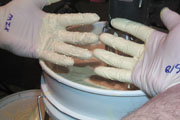In the adhesives and sealants industry, rotor/stators are used for particle size reduction of various solids. Rotor/stators are commonly used to "cut in" rubber solids and speed up the solution of these solids into various solvents. Sometimes the rotor/stator is used to disperse or break down an additive such as an accelerator or a pigment.
When your objective is an extremely fine "off-gage" dispersion, you are really talking about a sub-micron average particle size with narrow particle distribution. Generally, a media mill is required to achieve these results. In ultra-fine grinding, the rotor/stator is considered a pre-mixing device.
Preparing a good pre-mix for your pigment dispersions can present many problems, especially products with a low starting viscosity. Many times, this viscosity will increase substantially when the pigment agglomerates are broken down and properly dispersed. A traditional high-speed disperser blade is not very efficient in breaking down solids in low-viscosity dispersions because of the absence of hydraulic shear or viscous drag. Many people waste time and energy and put a lot of heat into the batch by trying to beat up a low-viscosity pre-mix to the point where it can be efficiently processed in a media mill.

Emphasis on Pre-Mix Particle Size
Let's discuss the use of rotor/stator mixers as pre-grinding devices used to prepare slurries, dispersions or suspensions of solids in liquid-vehicle systems. It is clear that rotor/stator mixers have shown the capability to produce much finer particles than a single high-speed dispersion blade, and thus dramatically reduce the pre-mix particle size of products that are fed into media mills. Obviously, the finer pre-mix particle size can greatly improve the production rates (efficiency) of continuous media mills. We put great emphasis and analysis on the starting particle size or pre-mix particle size of products before pumping them through our continuous media mills to achieve the ultra-fine finished dispersion.So, if you have come to the conclusion that you need a rotor/stator, how do you know the type that is best suited for your application? Rotor/stator mixers can be classified in general terms with similar characteristics:
- High-flow, medium-flow or low-flow capacity;
- High-shear, medium-shear or low-shear capability;
- Single-stage or multiple-stage designs with many rows of teeth, or slots;
- In-line machines with mechanical seals vs. vertical, tank-mounted units; and
- Materials of construction and abrasion-resistant considerations.
The second most common problem with rotor/stators is dealing with abrasive solid particles. Most rotor/stator devices operate at fairly close tolerances between the grinding surfaces and also contain shaft bushings that are submerged in the dispersion. A small change in clearances caused by routine wear can cause a dramatic drop-off in dispersion quality in some rotor/stator designs.

Rotor/Stator Mixer Avoids Common Pitfalls
With these concerns in mind, we have designed the Vertical Max Shear (VMS) rotor/stator mixer with a balanced approach that is well suited to a wide range of applications. The VMS rotor is designed with a high suction and pumping capability, with an increased height-to-diameter ratio. This provides a large grinding surface area between the tip of the rotor blade and the inside wall of the stator. In other words, the VMS rotor/stator is taller and narrower in comparison to many other rotor/stator designs. This can increase grinding efficiency in certain applications. Interchangeable VMS stators are available with various slot openings to maximize flow or maximize particle size reduction, whichever is desired.The VMS rotor/stator was designed with particle size reduction as the main objective but also with a high pumping capability for rapid circulation and blending of liquids for less stringent rotor/stator applications. As standard equipment, the VMS includes an adjustable down-thrust impeller for increased circulation and the ability to handle a wider viscosity range. An abrasive-resistant ceramic shaft coating is also standard to handle dispersions of pigments and other abrasive solids in suspension.
Which rotor/stator is best suited to your application? Consider the characteristics of your product such as temperature sensitivity and abrasive-solids content. Then test different types of rotor/stator devices to get the best combination of flow vs. shear that will produce the results you need for your product - whether the rotor/stator is used as a pre-mix device or to manufacture a finished product.
For additional information on the Vertical Max Shear rotor/stator mixer, contact Premier Mill, A Lightnin Company, One Birchmont Drive, Reading, PA 19606-3298; phone 610-779-9500; fax 610-779-9666; e-mail pmsales@lightnin.spx.com; or visit the Web site www.premiermill.com. Or Circle No. 75.